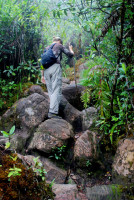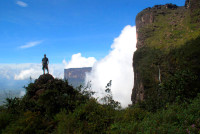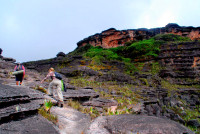Thankfully the day dawns bright and clear and Roraima reappears out of the gloom in all its majestic glory. This little victory is enough to change the mood of the camp and Christi and I set off on our summit attempt. It’s only 3 km from our base camp to our euphemistically entitled hotel for the night, but most of the hike is vertical: base camp is at 1870m, the hotel Indio at 2700m. It takes more than 4 grueling hours of clambering over rocks, sloshing through muddy trails, and scrambling through dense, lush rainforest to reach the top. On the final summit ramp there are even water falls to negotiate and Christi is thankful for the stick one of our porters cut for her to help with her balance. We are exhausted by the time we finally drag ourselves off the trail and onto the summit of Roraima. Marketing departments must love working with the spectacular natural features found in South America because they all have such inspiring tag lines: The Lost City of the Incas (Machu Picchu) and The Devil’s Throat (Iguazu Falls) to name but two. And Roraima sits happily in this company with the tag-line, The Lost World.
According to legend, it was the mystique surrounding Roraima that gave Sir Arthur Conan Doyle his inspiration for the book, ‘The Lost World’, where dinosaurs still roamed in splendid isolation. Sadly the dinosaurs are feeling a little camera shy today. None come to check us out – or try to eat us. Although tepuis such as Roraima are made of sandstone, cyanobacteria have stained them black, aside that is from the trails where the pink color stands out against the dark, eerie mist-shrouded summit. Our main goal is to grab a hotel (no advanced bookings accepted!) and fortunately we get one with a 5 star view, the hotel Indio. The remainder of the facilities, basically a dry overhang, are a little less inspiring, however. (Note tepui is a Pemon word meaning mountain).
Roraima tepui has sheer cliffs over 500m in height and covers an area of 34 km2. Roraima is simply the biggest tepui in Venezuela. Its weathered sandstone surface has given rise to some weird rock formations, such as the flying turtle and the Jacuzzi. Flash floods and constant rain have created a harsh, but life still finds a way. Mice and black frogs are the main endemic animal species, although oilbirds nest on the cliff face, and the amazing coati wanders up occasionally from the lowlands. There are also a surprising variety of plants, including small trees that cling to life in this nutrient-poor, shallow soil environment.
Blog post by Roderick Phillips, author of Weary Heart – a gut-wrenching, heart-wrenching, laugh-wrenching story.







Speak Your Mind